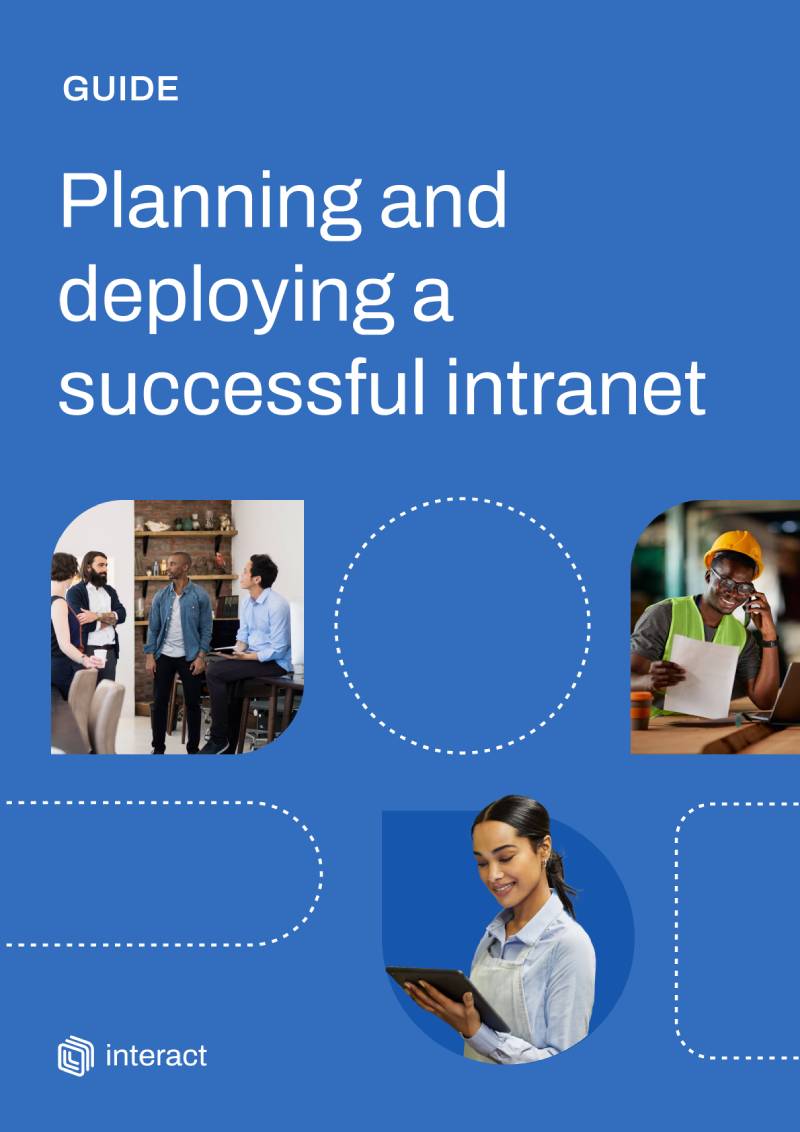Don’t expect your leaders to immediately engage with your intranet. Sometimes, you just need to help them understand the value of your organization’s platform. But do it well and their championing could be your greatest intranet engagement tool.
In many cases, when intranets are launched, leaders tend to overlook their significance. With an able intranet team at the helm, what use are senior figures?
However, a strong leadership involvement is critical to every intranet strategy and leaders are key to your system’s success. From posts to comment, to cheerleading and promoting the platform – these are the people with the greatest influence, who can turn a system which is in its infancy to a must-have digital tool.
But without strong-arming them into your project, many senior leaders have a tendency to stay away. But their role in your plan is an important one, so what are the most effective ways of getting your leaders to use the company intranet? We’ll look at the many methods that the most successful businesses have adopted and explore the stumbling blocks you may encounter.
Why is it so important to have your leaders on your intranet?

Leaders are critical in every project. When you’re setting up a new intranet or need to engage more of your workforce on an existing platform, it’s your leaders who have a powerful role to play in using it. If you’re looking to get your intranet to the next level, it might be useful to remember how essential stakeholder support is to your project. The backing of your leaders can contribute to:
- The recognition of the value of an intranet
- The removal of cultural blockers to software adoption
- Adoption and engagement through the examples set by top-level
- A reduction of timescale and budget complications
- Assistance with planning and strategy
- The continued development of the intranet in line with organizational objectives
And right now, organizations need their leaders. Gallup Panel data from June 8-14 show that U.S. employees and managers are about 20% less likely than they were in May 2020 to strongly agree that employers are communicating plans effectively and preparing their employees for the post-COVID workplace.
If employees don’t feel supported or informed, their performance, engagement and wellbeing are on the line — which puts bottom-line outcomes at risk too.
Gallup
Now more than ever, leaders need to reassess the way they are speaking to – and sharing plans with – their employees. Their presence on the intranet is key to making this happen.
Pushback

Every organization needs some kind of leadership figure. People follow leaders, are inspired by them, learn from them, copy them. To this end, people need to have influential figureheads to look up to. When you’re not able to be physically there, it’s important to make your presence known in other ways. An intranet is an effective medium for doing this.
Workers may be immersed in the day-to-day minutiae of their jobs, but when it comes to influencing, inspiration, and direction, your leaders are the people your workforce turn to. That’s why their visibility, whether it’s physical or virtual, is so important.
When it comes to their involvement in the intranet, the reception you will get from your leaders may be a mixed bag. You will have some leaders who will immediately recognize the value of having a presence on the company intranet. But you may also have others who are less receptive and initially might see the platform as another chore. The challenge is to show them exactly what an intranet can do for them – and how their presence on it can be both beneficial for themselves and for the organization as a whole.
Ways to get your leaders to use the intranet

The multi-channel infrastructure of an intranet means that there are several ways of using it to inspire, influence and inform users.
Involvement
Many senior-level leaders fail to recognize how transformative an intranet can be for an organization. Organizations can achieve great success by getting leaders involved from the very beginning. When individuals bear first-hand witness to the planning, hard work, and vision that goes into bringing an intranet to life, they too can become inspired and work out what goals they can achieve through the platform.
These stakeholders not only benefit from having an involvement in the formation of the system, but they can also act as cheerleaders in its launch, encouraging their teams to use and interact with the system from day one.
A key factor in the success of Home-Start’s intranet launch has been the interest and close involvement of senior management in the whole process. They made sure that from the very beginning, regular intranet planning meetings were always attended by at least one member of the senior leadership team.
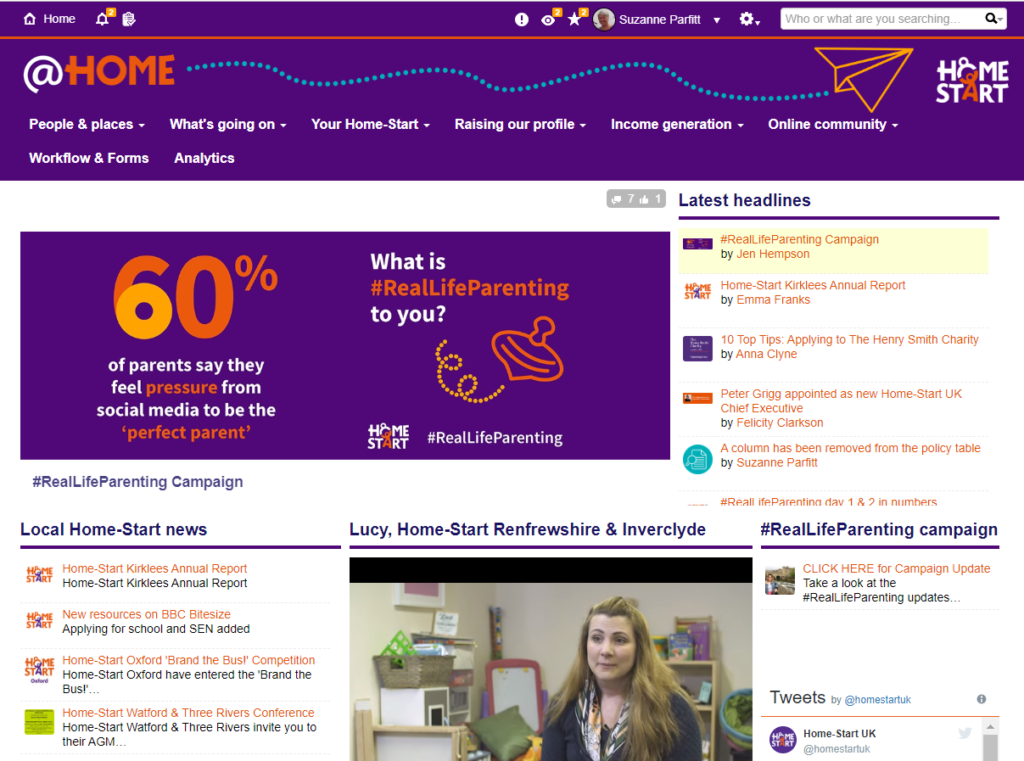
This enthusiasm is highlighted in the welcome video that was displayed on the homepage during the first few weeks of launch that features all of Home-Start UK’s senior managers, including the CEO. This involvement from the top gives a massive seal of approval to the extended workforce. A green light to use a system that is being used by everyone across the organization.
Aligning with a broader vision
In some cases, it doesn’t matter how many great features your intranet boasts. Leaders will have trouble seeing how investing in the system will get them to their goals. This is why it is so important to align your plan to a broader corporate vision.
Say, for example, the company’s goal is to improve customer service and reduce the number of support calls. An intranet can provide a hub for all scripts to help handle objections, issues, and product queries. It could provide further product information, stock amounts, and delivery updates. An intranet can be the frontline worker’s essential tool in providing a better service to every customer.
This was demonstrated in the Sheetz story. The chain of US convenience stores had experienced major problems with frontline staff being able to get product information. Prior to shifting to their new intranet, 36% of staff were spending over an hour a day on their intranet trying to find information to help them with their jobs. A frustrating and fruitless search often led to calls to Store Support for answers leading to an overburdened phone support system. Estimated costs on this problem alone was calculated at $19,000,000 a year in wasted time.
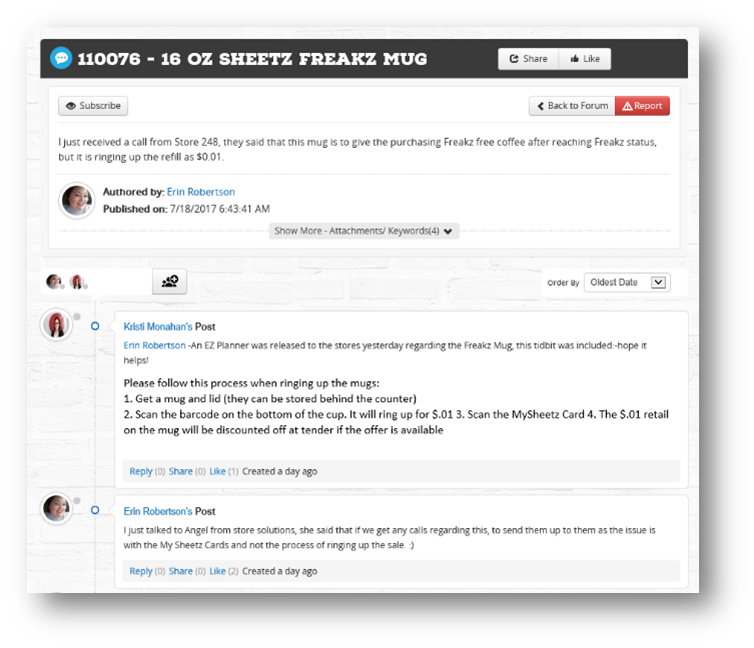
The new system was quickly embraced by staff as the go-to place for quality issues, questions and to share experiences. Providing a platform to problem-solve, offer support, and share knowledge has allowed Sheetz to save time, money, reduce workloads, and increase productivity among staff.
With this kind of vision, and an idea of cost savings across the business, leaders are immediately interested in making your intranet work.
Blogging
Ideally, a blog from leadership would be a weekly event. Unfortunately, most senior-level leaders are short on time, and being able to publish a well-written post every week is often unworkable.
But there are other forms of blogging that don’t involve long reads. Micro-blogging, sharing pictures or memes are all different ways of connecting with your users. One of our favorite examples of this is Steve George, customer services director at South East Water, the UK utility company. Unable to spend extended periods of time on writing an extensive blog, George instead used the intranet to share selfies of where he was that say, whether it was a training session in a satellite office or a site visit.
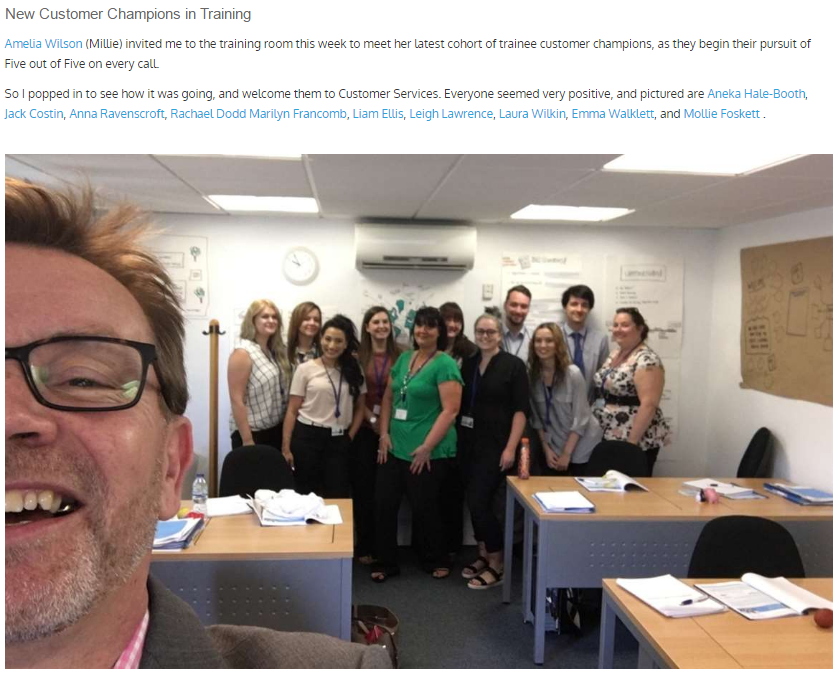
Publishing these pictures on the intranet also allowed him to introduce members and associates of the organization, in a shorthand way that was engaging and entertaining. This form of engagement took seconds to do, but has been so effective in keeping the workforce up-to-date with his work, and his interactions with other areas of the business.
Of course, when it’s possible to post a blog, it should actively be encouraged. In some situations, they are critical, especially in a time of change or crisis. A blog from a leader published on the intranet is incredibly useful in informing, reassuring, and supporting employees when they most need it.
Recognition
The act of recognition is extremely effective. Rewarding and recognizing your fellow colleague is a powerful way to single someone out for good work. According to a recent study, 69% of employees say they would work harder if they felt their efforts were better appreciated.
Senior-level needs to understand the value and strategic importance of employee recognition and be upskilled in how to show appreciation for employee contributions and effort. According to a recent poll, when asked what leaders could do more of to improve engagement, 58% of respondents replied, ‘Give recognition’ (Source: Psychometrics)
Putting a system in place that does this is a very effective way of making your workforce feel valued and showing gratitude. While implementing a peer-to-peer recognition system is recommended for every organization, it is also critical that leaders use it themselves. For senior-level, this is a prime example of something that takes moments but has a big impact – a quick-win for any figure who is short on time but wants to show gratitude to an employee.
When an employee is singled out by a leader, it holds an incredible amount of cache and value and can be incredibly encouraging for the employee. It also serves as a signifier to the organization as a whole that senior level, while not always physically visible, are engaged with the platform and are aware of the good work being done among teams.
Video
There is possibly no more effective tool to “being seen” than video, and a modern intranet supports video media to great success. The merits of video are well documented, and it’s a must-have in any intranet engagement campaign. They convey a complicated concept into a digestible message, they’re easy to create, and they’re engaging. According to Syndacast, using the word “video” in an email subject line boosts open rates by 19% and clickthrough rates by 65%.
Your Housing Group’s People Plus director, Steven Joyce is one of their intranet’s biggest influencers. His focus was to bring engaging, digital communications to the Group’s employee base principally through video. The company has been busy promoting remote working. With this in mind, he knew that video could allow the team to experience a better way of communicating despite not being face-to-face. Furthering his role of intranet cheerleader, Stephen stars in many of the videos. This, in turn, empowers other senior leads to use this method of communication, too – furthering stakeholder support.

Comments and likes
Engagement could also come in other forms like social interaction on other people’s posts. This is a quick and easy way to show your workforce that you’re present and interested in what they are up to. A comment or a like from leadership is a valuable way of highlighting relevant and interesting content. It provides a casual reach out from senior leader to employee and acts as a virtual thumbs up.
A good example of this is from Anthony Wagerman, who as CEO of international financial services provider Travelex, and winner of Best Stakeholder in the 2017 Intranet Excellence Awards was keen to up his visibility across the organization. He demonstrated the power of simple, small gestures to increase his presence on the intranet. Alongside his monthly vlog and weekly “Friday Night Updates” for the senior leadership team, Anthony takes an active role in responding to and engaging with, employee blogs and forums across their company-wide intranet, The Lounge.
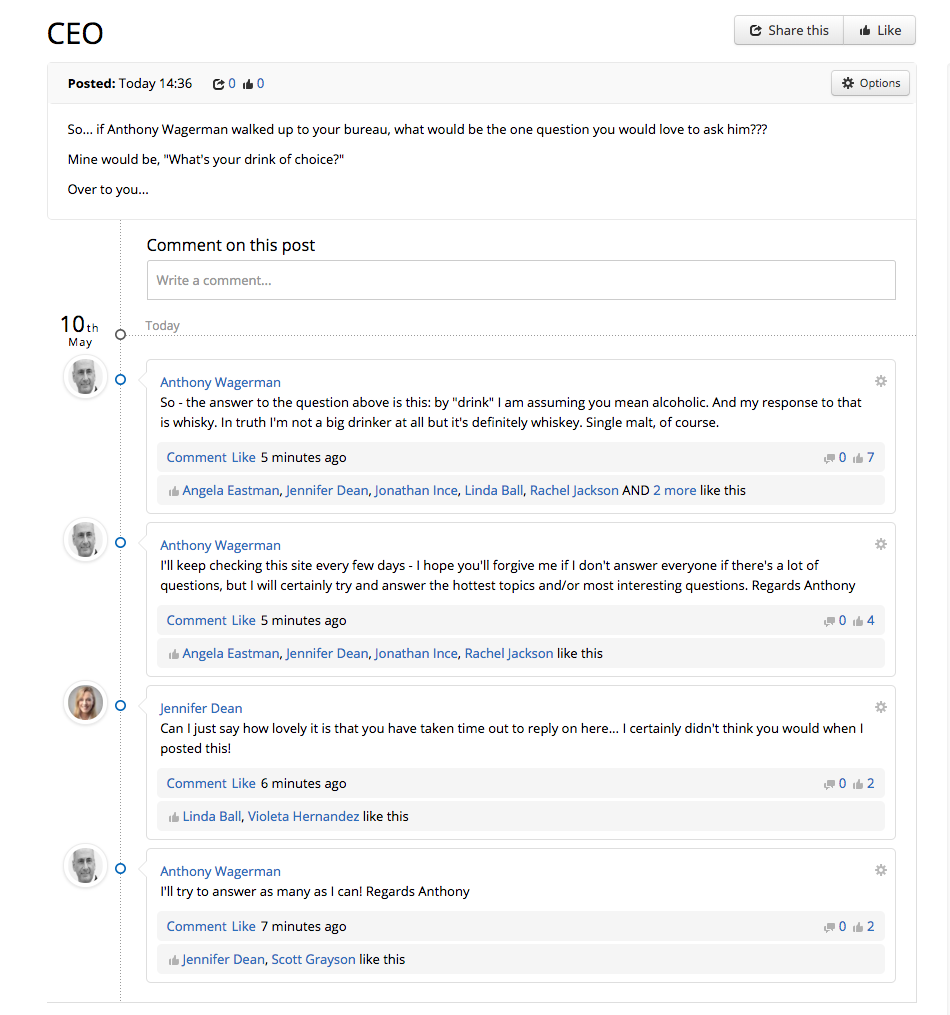
Knowledge sharing

Most leaders follow business bloggers or search out interesting articles on their field. Using your intranet to share interesting articles is an effective way of putting relevant material in front of your audience. It helps build and retain collective knowledge. When you share good ideas and fresh perspectives with your users, it also increases the capacity for innovation. By showing how and why, you allow employees to start thinking in different ways. This can open up brand new ways of looking at things and innovative ways of working.
Creating an environment where knowledge sharing is encouraged makes a positive difference in the relationship that the employee has with their workplace. And styling the intranet as a place of learning contributes to a positive workplace culture.
Ultimately, when you’re promoting your intranet, don’t presume leaders will automatically jump on the opportunity. Most senior level figures need nudging, and empowering them with the right channels and ideas for how to communicate effectively is essential to get their buy-in.
You could have the best intranet in the world, but without stakeholder support you are missing a valuable component that could see initial engagement slide. Making sure your leaders are visible using your intranet day-to-day is instrumental in making the system work.
“People follow the leader, and senior figures can make or break a system. Ensuring they are buying in to the project from the very beginning is key to your intranet’s success.”
To do this, they need background information: why does your organization need an intranet, what does it offer your business, why is it worth the significant investment. If you don’t explain why, there is little chance your leaders will see the importance.
But once the benefits of the system are revealed, your senior level can be your biggest cheerleaders, championing the intranet in every corner of the business. Even a simple comment can be approval to your employees and a signal to everyone that their ideas, opinions, and interactions on the intranet are seen, acknowledged, and valued.
